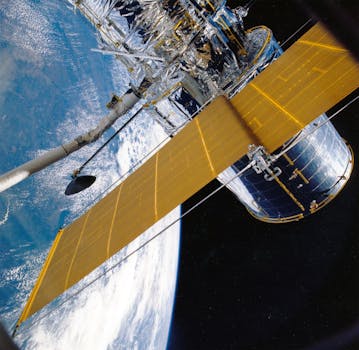The Future is Now: Exploring the Cutting-Edge Innovations in Satellite Telecommunications
The satellite telecommunications industry is rapidly evolving, with cutting-edge innovations transforming the way we communicate and access information. This article explores the latest advancements in satellite technology and their potential impact on the future of telecommunications.

The Future is Now: Exploring the Cutting-Edge Innovations in Satellite Telecommunications
Satellite Telecommunications is revolutionizing the way we communicate and access information, and the future is now. The satellite telecommunications industry is rapidly evolving, with cutting-edge innovations transforming the way we communicate and access information. From high-throughput satellites to advanced antenna systems, the latest advancements in satellite technology are poised to revolutionize the telecommunications industry.
Introduction to Satellite Telecommunications
Satellite telecommunications involve the use of satellites to transmit and receive data, voice, and video signals. The industry has come a long way since the launch of the first commercial communications satellite, Intelsat 1, in 1965. Today, satellite telecommunications play a vital role in providing connectivity to remote and underserved areas, as well as supporting critical infrastructure such as navigation, weather forecasting, and emergency communications.
One of the key drivers of innovation in the satellite telecommunications industry is the increasing demand for high-speed internet access. The growing need for broadband connectivity has led to the development of high-throughput satellites (HTS), which offer faster data rates and greater capacity than traditional satellites. HTS systems use advanced technologies such as spot beams and frequency reuse to maximize bandwidth and minimize interference.
Advancements in Satellite Technology
Several advancements in satellite technology are transforming the telecommunications industry. Some of the key innovations include:
Advanced antenna systems, which enable satellites to transmit and receive signals more efficiently and effectively. These systems use phased arrays and other technologies to steer beams and maximize bandwidth.
High-power amplifiers, which enable satellites to transmit signals with greater power and efficiency. These amplifiers use advanced materials and designs to minimize size and weight while maximizing performance.
Next-generation satellite systems, which offer improved performance, capacity, and flexibility. These systems use advanced technologies such as software-defined radios and digital signal processing to optimize performance and minimize costs.
Applications of Satellite Telecommunications
Satellite telecommunications have a wide range of applications, from providing broadband access to remote areas to supporting critical infrastructure such as navigation and emergency communications. Some of the key applications of satellite telecommunications include:
Broadband access, which enables users to access high-speed internet services from anywhere in the world. Satellite broadband is particularly useful in areas where terrestrial connectivity is limited or non-existent.
Navigation, which relies on satellite signals to provide location information and timing signals. Satellite navigation systems such as GPS and GLONASS are used in a wide range of applications, from aviation and maritime to automotive and consumer electronics.
Weather forecasting, which uses satellite data to predict weather patterns and track storms. Satellite imagery and data are used to monitor weather conditions, track climate change, and predict natural disasters such as hurricanes and wildfires.
Conclusion
In conclusion, the satellite telecommunications industry is rapidly evolving, with cutting-edge innovations transforming the way we communicate and access information. From high-throughput satellites to advanced antenna systems, the latest advancements in satellite technology are poised to revolutionize the telecommunications industry. As the demand for high-speed internet access continues to grow, satellite telecommunications will play an increasingly important role in providing connectivity to remote and underserved areas, as well as supporting critical infrastructure such as navigation, weather forecasting, and emergency communications.




